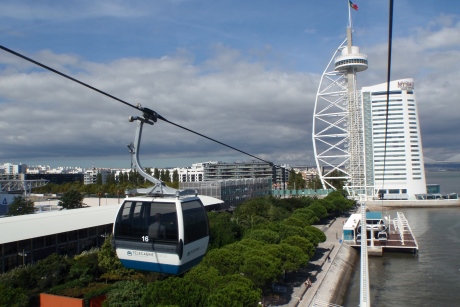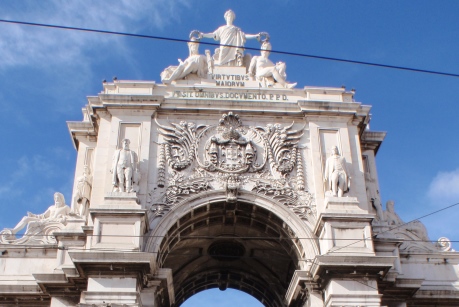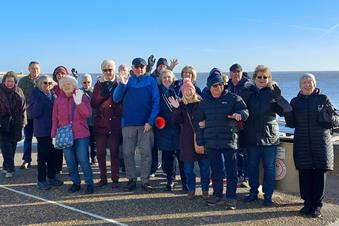
Pictured: Parque das Nacoes in Lisbon.
Discover what the Portuguese capital has to offer groups.
The Portuguese capital, Lisbon, is a city that both celebrates its rich history whilst also embracing the ultra modern. Lisbon wraps itself around the River Tagus on the edge of the Atlantic, which was once the last thing brave Portuguese sailors saw as they eked out in search of the New World.
Tantalising remnants of those days linger on in the historic Belem district, whilst the ultra modern is on show at the Parque das Nacoes, the old 1998 World Expo site, an example of how a global event can trigger urban regeneration.
Lisbon is a gloriously fun city for groups to explore with a network of trains and trams, but also ferries, funiculars and even the very Portuguese elevadors that just take you up to enjoy the views.
Outside the city centre the beach suburbs of Cascais and Sintra tempt in summer, whilst in the hinterland rises the chocolate box pretty hilltop oasis of Sintra.
Essential sights
Rua Augusta Arch: This historic arch is in the central Baixa district and dates back to the 18th century. In recent years it has been opened up, with its viewing terrace offering sweeping views of the Baixa and out on to Praca do Comercio, the city’s main square.
Tram 28: This vintage tram is the most atmospheric way to rumble around the most charming, historic districts of the city. It ekes off from the Baixa, heads up past the city’s striking cathedral and on up towards Lisbon’s landmark castle. To make sure of a seat groups should board at the first stop at Praca do Martim Moniz.
Parque das Nacoes: The old Expo site has been brilliantly converted for both tourism and local leisure pursuits. It is home to Europe’s second largest aquarium, the Oceanario, whose attractions include turtles, rays and sharks. There are concert venues, parks, art installations and the Pavilion of Knowledge science museum, with its mind-boggling exhibits. The best way to get a feel for the area is on the cable car, which also opens up yawning views of the Tagus.

Pictured: Rua Augusta Arch.
Food and drink
Since Lisbon sits right on the Atlantic Ocean it is no surprise that seafood is integral to the city’s cuisine. It can be savoured in myriad ways, from the simple grilled sardine stalls of the Alfama, through to hearty traditional inns, and on to Michelin star fine dining temples.
The number one seafood delicacy is Bacalhau. The idea of salted cod may not sound too appealing, but it is cooked in various ways. The locals indeed are not joking when they insist that there is a way to cook Bacalhau for every day of the year.
The Portuguese have a famously sweet tooth. There are countless pastelarias (cake shops) dotted around the city. The most famous is the Pasteleria de Belem, where the world famous pastel de nata egg tart pastry was first created.
Where to stay
The Pestana Palace: This is the plushest place to stay in town; a designated National Monument boasting lavish architecture, lush subtropical gardens and an outdoor swimming pool.
Pousada de Lisboa: Newly opened, this boutique hotel is in a historic building that sports a spectacular location on the city’s lifeblood Praca do Comercio, as well as a superb restaurant offering modern Portuguese cuisine.
Janelas Verdes: Translated as the green windows, Janelas Verdes is a relaxed, stylish boutique hotel between the centre and Belem, which sports some rooms with river views.

Pictured: Sintra.
Best for groups
You really need to get out on the water to appreciate Lisbon’s grandeur. Lisbon by Boat has a number of options for groups (both public tours and exclusive use), from standard sightseeing trips, through to speedboat experiences and dramatic evening cruises.
Head for the hills – the forested slopes around Sintra are awash with palaces and the ramparts of a Moorish Castle. Muit Adventure can take groups off the tourist trail with their bespoke walks.
Cycling Rentals organises a range of guided cycle tours in the hills around Sintra. These range from relatively gentle affairs, snaking up around the local Moorish castles and the UNESCO listed palaces, through to testing mountain biking adventures.
Fact file
Journey Time: 2.5 hours London-Lisbon.
Currency: Euro.
Best time to go: Early autumn and late spring are the best times outside the heat and humidity of summer and the Atlantic storms of winter.















